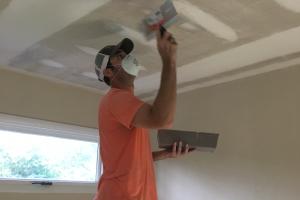Mastering the Art of Ceiling Sanding: A Comprehensive Guide

-
Quick Links:
- 1. Introduction
- 2. Understanding Different Ceiling Types
- 3. Tools and Materials Required
- 4. Preparation Before Sanding
- 5. Step-by-Step Sanding Techniques
- 6. Finishing Touches After Sanding
- 7. Common Mistakes to Avoid
- 8. Case Studies and Real-World Applications
- 9. Expert Insights
- 10. FAQs
1. Introduction
Sanding a ceiling is a crucial step in home improvement projects, particularly when preparing surfaces for painting or refinishing. This guide will walk you through the entire process of sanding a ceiling, from preparation to execution, ensuring a smooth and professional finish.
2. Understanding Different Ceiling Types
Before diving into the sanding process, it is essential to recognize the type of ceiling you are working with. Here are the most common types:
- Flat Ceilings: Smooth and uncomplicated, flat ceilings are the easiest to sand.
- Textured Ceilings: These may have a popcorn finish or knockdown texture, requiring more effort to sand.
- Vaulted Ceilings: Typically found in large rooms, these ceilings may need scaffolding for proper sanding.
3. Tools and Materials Required
The success of your sanding project heavily relies on having the right tools. Here’s a list of necessary items:
- Sandpaper (120 to 220 grit)
- Sanding pole
- Sanding block
- Dust mask and goggles
- Drop cloths
- Vacuum cleaner with a HEPA filter
- Paint roller and tray (for applying primer or paint afterward)
4. Preparation Before Sanding
Preparation is key to achieving a flawless finish. Follow these steps:
- Clear the room of furniture and cover the floor and walls with drop cloths.
- Inspect the ceiling for any damage, such as cracks or peeling paint.
- Repair any damages using spackle or joint compound, and allow it to dry completely.
- Ensure adequate lighting to spot imperfections and areas needing attention.
5. Step-by-Step Sanding Techniques
Now that you're prepared, follow these steps to sand your ceiling effectively:
- Choose the Right Grit: Start with a coarser grit (120) to tackle rough spots, then switch to a finer grit (220) for a smooth finish.
- Attach Sandpaper to the Pole: Secure sandpaper onto your sanding pole to reach high areas without a ladder.
- Begin Sanding: Work in small sections, using circular or back-and-forth motions. Always keep the pole at a slight angle to avoid gouging.
- Vacuum Frequently: Keep your workspace clean by regularly vacuuming dust between sanding sections.
- Check for Smoothness: Run your hand over the surface to check for smoothness and repeat sanding as necessary.
6. Finishing Touches After Sanding
Once sanding is complete, it’s time for the finishing touches:
- Clean the ceiling thoroughly to remove any dust.
- Apply a primer if you're painting over the surface.
- Consider using a paint roller with a long nap for textured ceilings.
7. Common Mistakes to Avoid
Even experienced DIYers can make mistakes. Here are common pitfalls to watch out for:
- Skipping repairs before sanding.
- Using too coarse of sandpaper initially.
- Failing to wear protective equipment.
- Neglecting to clean the ceiling before painting.
8. Case Studies and Real-World Applications
Understanding how others have successfully sanded their ceilings can provide valuable insights:
Case Study 1: A homeowner renovated a 1980s living room with a textured ceiling. By using a sander with a vacuum attachment, they significantly reduced clean-up time.
Case Study 2: In a small apartment, a professional contractor used a scaffolding system to sand a vaulted ceiling, ensuring safety and efficiency in the process.
9. Expert Insights
We spoke with professional contractors to gather expert advice on ceiling sanding:
"Always sand in sections and don’t rush the process. Quality over speed will yield the best results." - John Doe, Professional Contractor
10. FAQs
1. How often should I sand my ceiling?
It depends on the wear and tear, but generally every few years or before painting.
2. Can I sand a ceiling with a regular hand sander?
Yes, but a sanding pole is recommended for overhead work.
3. What grit sandpaper is best for ceilings?
Start with 120 grit and finish with 220 grit for smoothness.
4. Should I wear a mask while sanding?
Yes, to protect against inhaling dust particles.
5. How do I clean up after sanding?
Use a vacuum with a HEPA filter and damp cloths to minimize dust.
6. Is it necessary to prime after sanding?
Yes, particularly if you are painting over a previously painted surface.
7. Can I use a power sander?
Yes, but be cautious to avoid damaging the ceiling.
8. What’s the best time of year to sand a ceiling?
Spring or fall, when humidity levels are lower.
9. How long does the sanding process take?
It varies, but expect several hours depending on the ceiling's condition.
10. Are there any professional services for ceiling sanding?
Yes, many home improvement companies offer this service.
Random Reads